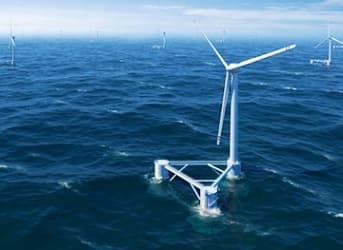Wind power has great potential, and researchers have even estimated that offshore, floating wind farms could provide as more than 20% of the world’s energy needs in the future. The main problem that dogs wind energy is the fact that when the wind doesn’t blow, no electricity is produced, and intermittent energy is of little use to a grid.
Various forms of energy storage have been researched by different groups around the world. Ideas such as giant flywheels, carbon neutral gas, giant batteries made from gravel and argon gas, and pumped hydro energy storage systems, have all been tested to some extent.
A group of researchers at MIT, including Alexander Slocum and Brian Hodder, have developed a new method for storing energy for steady release when the wind is not blowing.
Related article: UK Ministry of Defense Deems Wind Towers a National Security Threat
Their technique sees giant 25 metre wide hollow concrete spheres anchored in the oceans depths. As the wind blows and the offshore floating wind turbines produce electricity the majority is sent to the grid, but some is used to pump the seawater out of the sphere. When the wind dies and the turbine stops to produce electricity the pumps turn off and the seawater rushes back into fill the hollow space. The rushing water flows through a turbine which then generates electricity.

PopSci have a great diagram to explain the concept in a visual medium.
Related article: Has Belgium Cracked the Problem of Storing Wind Power Electricity?
The MIT team calculated that one 25 metre sphere anchored at a depth of 400 metres could store the equivalent of six megawatt-hours of power, meaning that a few hundred would produce the same amount of power as a nuclear power plant does in one hour.
Initial estimates put the price of building one sphere in the region of $12 million, three or four times more than the cost of an average, onshore wind turbine.
By. Charles Kennedy of Oilprice.com


















